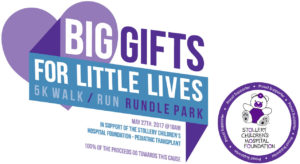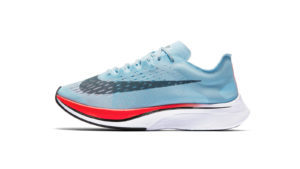
With 5 weeks remaining before the race, this is the 2nd of 5 blogs to help you prepare!
 Just recently, Nike released the particulars behind their new Zoom VaporFly Elite shoe that they hope will help a group of elite runners break the 2-hour barrier in the marathon distance. With a heel that boasts an 80% energy return and a forefoot at 77% return, the shoe sounds too good to be true, all weighing in at only 6.9 ounces for a men’s size 10. In a lab test, a competitive runner who ran at marathon pace with the shoe, demonstrated reduced muscle activity in his quadriceps, calf and shin muscles as well as a reduced heart rate, indicating less effort required to maintain this pace. So, on May 6, 7 or 8 (depending on weather conditions), the world awaits with bated breath to see if 3 elite runners can break the 1:59:59 barrier while running with this super shoe.
Just recently, Nike released the particulars behind their new Zoom VaporFly Elite shoe that they hope will help a group of elite runners break the 2-hour barrier in the marathon distance. With a heel that boasts an 80% energy return and a forefoot at 77% return, the shoe sounds too good to be true, all weighing in at only 6.9 ounces for a men’s size 10. In a lab test, a competitive runner who ran at marathon pace with the shoe, demonstrated reduced muscle activity in his quadriceps, calf and shin muscles as well as a reduced heart rate, indicating less effort required to maintain this pace. So, on May 6, 7 or 8 (depending on weather conditions), the world awaits with bated breath to see if 3 elite runners can break the 1:59:59 barrier while running with this super shoe.
All things being equal, it has been shown that a lighter shoe can improve a runner’s running economy. However, with the minimalist craze now over, the pendulum swung to the other extreme to the promotion of shoes with very high cushioning (thanks to Hoka). With so many different kinds of shoes to choose from, I am often asked by runners which shoe is best for them. With an attempt to simplify shoe selection, there is some research evidence that propose that comfort is the best gauge of finding the right shoe. Indeed, comfort is essential. Regardless of how “super” a shoe is, if the shoe is not comfortable, then it is not the right shoe for you.
However, the question that begs to be asked is this: “If a maximalist, minimalist and somewhere-in-between shoe all feel comfortable, from which shoe do you choose?” Some research is suggesting that you purchase all 3 since running in different kinds of shoes can help reduce running injuries. The different shoes are altering the stresses on your body which is both protective and adaptive. However, if your budget is limited, or more importantly, if you are struggling with an injury, then shoe selection is a vital process that requires care and attention.
Physical Therapists are specialists in movement disorders that result from pathology. We are specialists in biomechanics and some have taken a strong interest in running biomechanics as it relates to injury or disease. As such, shoe selection like exercise prescription must be tailored specifically to the individual based on a thorough history, physical assessment, and gait analysis. It is based on a clinician’s experience and expertise in the field of running and running biomechanics and running-related injury management and research evidence. It is based on a rigorous clinical reasoning process that takes into account multiple factors. There are many running shoe stores today that provide video gait analysis to assist in shoe selection. If you are not struggling with an injury, then these might suffice. However, if you are struggling with an injury, or if you are new to the sport of running, then my advice is to consult with a Physical Therapist with a special interest in running and running-related injuries who will be in a better position to offer you advice.
Here at Elevation Physiotherapy, we are pleased to announce that we have established a collaborative relationship with 4 Running Room stores to assist you in choosing your next running shoe: St. Albert, Callingwood, 109 Street and South Edmonton Common. We can provide recommendations for your next shoe purchase and you can take our written prescription to any one of these Running Room stores and receive a 10% discount on your purchase.
With 5 more weeks before the race, if you are thinking about new shoes, be sure to get them soon.
Submitted by Albert and Karen Chan.

